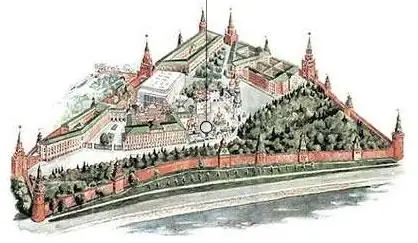- Author Harold Hamphrey [email protected].
- Public 2023-12-17 10:06.
- Last modified 2025-01-24 11:10.
In Istanbul, the Sultanahmet area is the most popular tourist destination. It is located in the historical part of the city. Geographically, it is located on a cape between the Bosphorus, the Golden Horn and the Sea of Marmara. Since 1985, the area has been a cultural heritage of humanity. Administratively, this place is part of the Fatih Administrative Region.
Sultanahmet Square is the undisputed landmark of Istanbul.

General information
All the most interesting things in the city of Istanbul are located within one square. This is the majestic Hagia Sophia, the magnificent Blue Mosque, an Egyptian obelisk, ancient Greek columns, a wonderful fountain (a gift to the Turkish Sultan from the German Chancellor) and much more.
The main square of Sultan Ahmed in Istanbul is located in the central historical part of the city. Conventionally, it is divided into two parts: the area between the Blue Mosque and Hagia Sophia and the areaThe hippodrome, where ancient obelisks and columns of the Byzantine period have survived to the present day, as well as the same German fountain, brought as a gift to Sultan Abdul-Hamid II from Wilhelm II (Kaiser of Germany). The square got its name from the mosque of Sultan Ahmet, located right there.

Blue Mosque
The historical square of Istanbul is decorated with this magnificent building. This beautiful mosque, which is one of the main symbols of Istanbul, is a masterpiece not only of Islamic, but of the entire world architecture. Its official name is Sultanahmet Mosque. Among tourists, it is better known as the Blue Mosque.

It is located opposite the Hagia Sophia, which in Byzantium was an Orthodox church, and later was rebuilt into a mosque. These two beautiful buildings are separated by a picturesque square with a fountain, where tourists stroll during the day and at night.
The mosque was built in 1609-1616 by the decree of Sultan Ahmed I. The author of the project is Sedefkar Mehmet Aga, who is a student of the great architect Mimar Sinan, who worked during the reign of Suleiman I (the Magnificent).
German Fountain
The decoration of Istanbul Square is also a German fountain, donated to the city in 1989. It was made in Germany and brought to Turkey unassembled. Installed it on the Hippodrome square. It is made in the form of an octagon in the neo-Byzantine style, and is decorated with golden mosaics from the inside.

On the inner surface of the dome, which is supported by columns, the initials of Wilhelm II and the monogram of Abdul-Hamid III are visible.
Hippodrome
On the site of the ancient Hippodrome is part of the central square of Istanbul. Its construction was started by Septimius Severus (Roman emperor) in 203. At that time, the city was called Byzantium.
When Emperor Constantine (330-334) created a new capital, the Hippodrome was completely rebuilt, after which its dimensions increased: length - 450 meters, width - 120 meters, capacity - approximately 100,000 people. Its territory was entered from the north side, approximately where the German Fountain stands today. Previously, the Hippodrome was decorated with a quadriga, which was taken to Venice in 1204.
At this hippodrome, chariot races were held, in the heat of passions leading to major showdowns, and sometimes to riots among the fans. The largest rebellion is the Nika uprising, which took place in 532 during the reign of Justinian. Constantinople was severely destroyed as a result of these actions, and approximately 35,000 people were killed.
Since 1453, after the conquest of Constantinople by the Turks, the Hippodrome has been used only as a venue for fairs, performances and other entertainment events.

Egyptian obelisk
On the historical square of Istanbul (at the Hippodrome) in 390, the obelisk of Theodosius (or the Egyptian obelisk) was installed, brought from Luxor by decree of Emperor Theodosius I. They installed it on a specially madepedestal made of marble. It depicts scenes with Theodosius and the scene of the construction of the obelisk at the Hippodrome.
This monument is the oldest sculpture in Istanbul. It dates back to the 16th century BC. e. Made from Aswan pink and white granite. The weight of the monument is 300 tons. Egyptian hieroglyphs are visible on all sides, demonstrating the heroic deeds of Pharaoh Thutmose III, and at the top is the god Amon and the pharaoh himself. The original obelisk was shortened during transportation from 32.5 meters to 18.8 meters.
Snake column
The column was brought to Istanbul Square in 326 from the Greek sanctuary of Apollo by order of Constantine the Great. This building symbolized the victory over the Persians of the Greek city-states in 479 BC. e.
Initially, the column had a height of 6.5 meters, it consisted of three snakes intertwined. It was crowned with a golden bowl, and the snakes themselves were made from the bronze shields of the Persians who fell in battle. In ancient times, the bowl was lost, and in 1700 the heads of snakes were broken. One of the heads is today an exhibit of the Istanbul Museum of Archeology. The height of the column is currently 5 meters.






